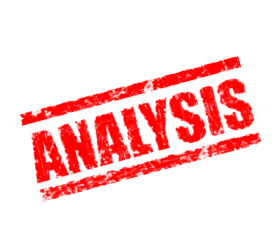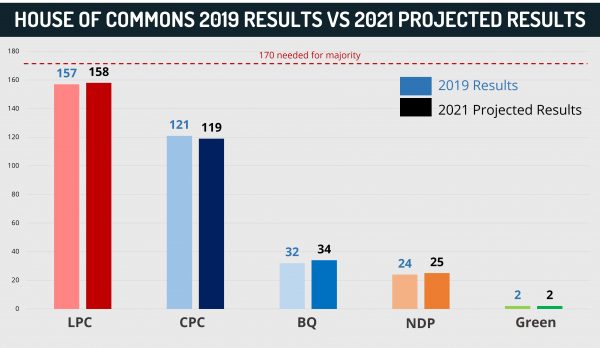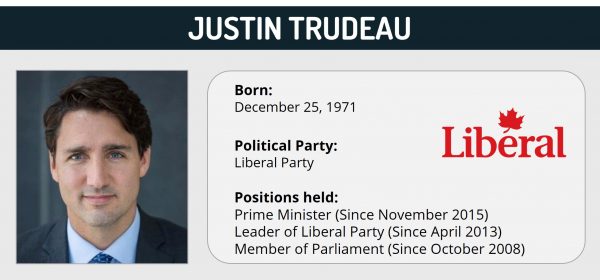22
Sep 2021
13:21 UTC
Canada Analysis: Trudeau-led LPC fails to gain parliamentary majority in snap election, likely to lead minority government with focus on pandemic mitigation, recovery
Executive Summary
- Prime Minister Justin Trudeau’s center-left LPC are projected to win 158 seats in the House of Commons, failing to obtain a parliamentary majority.
- Trudeau called the early election hoping to take advantage of what he believed to be voter satisfaction with his handling of the COVID-19 pandemic and vaccination rollout.
- LPC is likely to form a minority government with the outside support of the left-wing (NDP), the same governing structure as before the election
- COVID-19 pandemic mitigation and recovery, along with climate change and affordable childcare, are liable to be the main policy priorities of new government.
- Travel to Canada may continue as per government directives concerning COVID-19 restrictions.
Current Situation
- On September 20, Canada held parliamentary elections in which the Liberal Party of Canada (LPC) is projected to win 158 seats in the House of Commons (HoC) after the September 20 parliamentary elections. The center-right Conservative Party of Canada (CPC) is projected to win 119 seats, center-left Quebec-focused Bloc Quebecois (BQ) 34 seats, National Democratic Party (NDP) 25, and environmentalist Green Party of Canada (GPC) two. The far-right People’s Party of Canada (PPC) failed to win a seat in the HoC but garnered around 5 percent of the national vote.
- Although the LPC won a plurality of seats, the CPC came first in the popular vote with 33.9 percent. The LPC won 32.3 percent of the nationwide vote share, the NDP 17.7, BQ 7.8, and GPC 2.3. At around 59 percent of eligible voters, voter turnout was near historic lows.
Background
- Trudeau, who has been PM since 2015, called the snap election on August 15 as he assessed the LPC to be in a strong position to obtain a parliamentary majority due to their handling of the COVID-19 pandemic, including successful vaccination rollout.
- The five-week campaign saw polling indicating the CPC may win the most seats before falling in the final ten days of the campaign as COVID-19 cases and hospitalizations hit a critical point in Alberta province, which is led by CPC-aligned Premier Jason Kenney.
- Trudeau endured attacks from both his right and left flank throughout the campaign regarding his decision to call an early election in the midst of the COVID-19 pandemic and his inability to fulfill promises he made to the progressive portion of the electorate.
- Prior to the election, the LPC was governing in a minority government supported by the NDP on key policy issues.
Assessments & Forecast
Voter discontent with decision to call election during pandemic influenced the LPC not obtaining a majority
- Trudeau’s LPC not making significant gains was likely due to a general rebuke against the decision to call early elections during the COVID-19 pandemic. The low voter turnout is an additional indicator of voter cynicism regarding the early elections.
- Additionally, although the PPC failed to win a seat, they cut into CPC vote margins in key ridings in Ontario, Manitoba, and Saskatchewan, exposing a weakness in prime ministerial candidate Erin O’Toole’s centrist election strategy. With that, traditional conservative members of the CPC are likely to increase calls to move the party back to the right in future elections, rather than trying to court the centrist votes.
- The results indicate that although a significant proportion of voters were frustrated with Trudeau’s early election call, the Canadian electorate, in general, is looking for much of the same in terms of governance to see through the COVID-19 pandemic.
LPC are likely to lead a minority government with the support of the NDP
- FORECAST: The previous governing scenario of an LPC minority government led by Trudeau passing legislation with the support of the NDP in exchange for commitments to advance some of the NDP’s policy priorities is most likely to continue moving forward. There is also liable to be certain Quebec-oriented legislation being passed with the support of the BQ, in return for support on LPC priority issues.
- However, it is unlikely that the LPC will form a formal coalition with either the NDP or BQ as only coalitions are extremely rare in Canada, and none of the parties appearing to entertain the prospect of such an agreement.
- Given that the most likely governing scenario is identical to the previous governing situation, there is unlikely to be any major public policy changes in the short-to-medium term. That said, in the run-up to the 2023 elections, both the LPC and CPC may attempt to move policies away from the center in order to try to gain seats, with LPC liable to try to take NDP voters.
- FORECAST: In this respect, both Trudeau and O’Toole are likely to experience intraparty pressure following the election result with the possibility of both being replaced prior to a future election, with O’Toole being accused of not doing enough for right-wing voters.
COVID-19 pandemic mitigation and recovery to remain policy priority of new government into 2022
- The LPC minority government is liable to focus primarily on COVID-19 pandemic mitigation and recovery into 2022, with Trudeau stating that voters gave the LPC “a clear mandate to get Canada through this pandemic” on election night.
- Additional policy issues that the LPC minority government along with NDP support are likely to address include climate change, affordable childcare, and combating increasing housing prices. However, given the precarious support in the HoC, negotiations between the parties on these issues will mean that little progress is expected until 2022.
- FORECAST: The Trudeau-led minority government is liable to continue to boost public spending to offset the economic impacts of COVID-19 restrictions and health system funding issues in the near-to-medium term.
- FORECAST: With Canada experiencing an inflation rate of 4.1 percent in August 2021, the highest rate since 2003, and public spending expected to remain high after the snap election results, inflation is liable to remain a significant economic issue in the country moving forward. As such, should the pandemic begin to ease, Canada’s political sphere will likely return to focus on economics, social equality, and relations with the USA and Asia over the coming years.
Recommendations
- Travel to Canada may continue as per government directives concerning the ongoing COVID-19 restrictions.
- Those operating or residing in Canada are advised to remain cognizant of the ongoing political developments and the latent risk of unrest arising due to demonstrations by anti-vaccine groups and activists in the coming months.
- For more information on the security situation, please contact [email protected].
Executive Summary
- Prime Minister Justin Trudeau’s center-left LPC are projected to win 158 seats in the House of Commons, failing to obtain a parliamentary majority.
- Trudeau called the early election hoping to take advantage of what he believed to be voter satisfaction with his handling of the COVID-19 pandemic and vaccination rollout.
- LPC is likely to form a minority government with the outside support of the left-wing (NDP), the same governing structure as before the election
- COVID-19 pandemic mitigation and recovery, along with climate change and affordable childcare, are liable to be the main policy priorities of new government.
- Travel to Canada may continue as per government directives concerning COVID-19 restrictions.
Current Situation
- On September 20, Canada held parliamentary elections in which the Liberal Party of Canada (LPC) is projected to win 158 seats in the House of Commons (HoC) after the September 20 parliamentary elections. The center-right Conservative Party of Canada (CPC) is projected to win 119 seats, center-left Quebec-focused Bloc Quebecois (BQ) 34 seats, National Democratic Party (NDP) 25, and environmentalist Green Party of Canada (GPC) two. The far-right People’s Party of Canada (PPC) failed to win a seat in the HoC but garnered around 5 percent of the national vote.
- Although the LPC won a plurality of seats, the CPC came first in the popular vote with 33.9 percent. The LPC won 32.3 percent of the nationwide vote share, the NDP 17.7, BQ 7.8, and GPC 2.3. At around 59 percent of eligible voters, voter turnout was near historic lows.
Background
- Trudeau, who has been PM since 2015, called the snap election on August 15 as he assessed the LPC to be in a strong position to obtain a parliamentary majority due to their handling of the COVID-19 pandemic, including successful vaccination rollout.
- The five-week campaign saw polling indicating the CPC may win the most seats before falling in the final ten days of the campaign as COVID-19 cases and hospitalizations hit a critical point in Alberta province, which is led by CPC-aligned Premier Jason Kenney.
- Trudeau endured attacks from both his right and left flank throughout the campaign regarding his decision to call an early election in the midst of the COVID-19 pandemic and his inability to fulfill promises he made to the progressive portion of the electorate.
- Prior to the election, the LPC was governing in a minority government supported by the NDP on key policy issues.
Assessments & Forecast
Voter discontent with decision to call election during pandemic influenced the LPC not obtaining a majority
- Trudeau’s LPC not making significant gains was likely due to a general rebuke against the decision to call early elections during the COVID-19 pandemic. The low voter turnout is an additional indicator of voter cynicism regarding the early elections.
- Additionally, although the PPC failed to win a seat, they cut into CPC vote margins in key ridings in Ontario, Manitoba, and Saskatchewan, exposing a weakness in prime ministerial candidate Erin O’Toole’s centrist election strategy. With that, traditional conservative members of the CPC are likely to increase calls to move the party back to the right in future elections, rather than trying to court the centrist votes.
- The results indicate that although a significant proportion of voters were frustrated with Trudeau’s early election call, the Canadian electorate, in general, is looking for much of the same in terms of governance to see through the COVID-19 pandemic.
LPC are likely to lead a minority government with the support of the NDP
- FORECAST: The previous governing scenario of an LPC minority government led by Trudeau passing legislation with the support of the NDP in exchange for commitments to advance some of the NDP’s policy priorities is most likely to continue moving forward. There is also liable to be certain Quebec-oriented legislation being passed with the support of the BQ, in return for support on LPC priority issues.
- However, it is unlikely that the LPC will form a formal coalition with either the NDP or BQ as only coalitions are extremely rare in Canada, and none of the parties appearing to entertain the prospect of such an agreement.
- Given that the most likely governing scenario is identical to the previous governing situation, there is unlikely to be any major public policy changes in the short-to-medium term. That said, in the run-up to the 2023 elections, both the LPC and CPC may attempt to move policies away from the center in order to try to gain seats, with LPC liable to try to take NDP voters.
- FORECAST: In this respect, both Trudeau and O’Toole are likely to experience intraparty pressure following the election result with the possibility of both being replaced prior to a future election, with O’Toole being accused of not doing enough for right-wing voters.
COVID-19 pandemic mitigation and recovery to remain policy priority of new government into 2022
- The LPC minority government is liable to focus primarily on COVID-19 pandemic mitigation and recovery into 2022, with Trudeau stating that voters gave the LPC “a clear mandate to get Canada through this pandemic” on election night.
- Additional policy issues that the LPC minority government along with NDP support are likely to address include climate change, affordable childcare, and combating increasing housing prices. However, given the precarious support in the HoC, negotiations between the parties on these issues will mean that little progress is expected until 2022.
- FORECAST: The Trudeau-led minority government is liable to continue to boost public spending to offset the economic impacts of COVID-19 restrictions and health system funding issues in the near-to-medium term.
- FORECAST: With Canada experiencing an inflation rate of 4.1 percent in August 2021, the highest rate since 2003, and public spending expected to remain high after the snap election results, inflation is liable to remain a significant economic issue in the country moving forward. As such, should the pandemic begin to ease, Canada’s political sphere will likely return to focus on economics, social equality, and relations with the USA and Asia over the coming years.
Recommendations
- Travel to Canada may continue as per government directives concerning the ongoing COVID-19 restrictions.
- Those operating or residing in Canada are advised to remain cognizant of the ongoing political developments and the latent risk of unrest arising due to demonstrations by anti-vaccine groups and activists in the coming months.
- For more information on the security situation, please contact [email protected].





